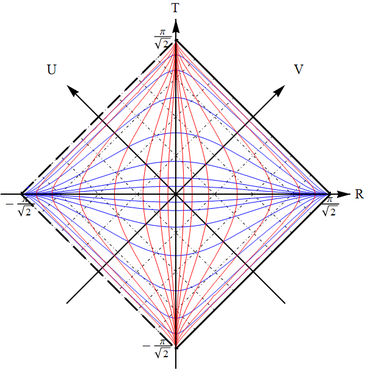Conformal diagrams: stationary black holes
In the context of black hole spacetimes there are many subtly distinct notions of horizons, with the most useful being different from those used in cosmology. In particular, particle horizons do not play any role. The event horizon is defined not with respect to some selected observer, but with respect to all external observers: in an asymptotically flat spacetime* a future event horizon is the hypersurface which separates the events causally connected to future infinity and those that are not. Likewise the past event horizon delimits the events that are causally connected with past infinity or not. Another simple but powerful concept is the Killing horizon: in a spacetime with a Killing vector field $\xi^\mu$ it is a (hyper-)surface, on which $\xi^\mu$ becomes lightlike. We will see explicitly for the considered examples that the Killing horizons are in fact event horizons by constructing the corresponding conformal diagrams. In general, in the frame of GR a Killing horizon in a stationary spacetime is (almost) always an event horizon and also coincides with most other notions of horizons there are.
This section elaborates on the techniques of constructing conformal diagrams for stationary black hole solutions. The construction for the Schwarzschild black hole, or its variation, can be found in most textbooks on GR; for the general receipt see \cite{BrRubin}.
* Meaning the spacetime possesses the infinity with the same structure as that of Minkowski, which is important.
Schwarzschild-Kruskal black hole solution
Problem 1: Schwarzschild exterior.
The simplest black hole solution is that of Schwarzschild, given by \begin{equation} ds^{2}=f(r)dt^2 -\frac{dr^2}{f(r)}-r^2 d\Omega^2,\qquad f(r)=1-\frac{r_g}{r}, \label{SchwBH} \end{equation} where $r_g$ is the gravitational radius, and $d\Omega^2$ is the angular part of the metric, which we will not be concerned with. The surface $r=r_g$ is the horizon. Focus for now only on the external part of the solution, \[\big\{-\infty<t<+\infty,\;\; r_g<r<+\infty)\big\}.\] The general procedure of building a conformal diagram for the $(t,r)$ slice, as discussed in the cosmological context earlier, works here perfectly well, but needs one additional step in the beginning: \begin{enumerate} \item use a new radial coordinate to bring the metric to conformally flat form; \item pass to null coordinates; \item shrink the ranges of coordinate values to finite intervals with the help of UNIQ-MathJax8-QINU; \item return to timelike and spacelike coordinates. \end{enumerate} Identify the boundaries of Schwarzschild's exterior region on the conformal diagram and compare it with Minkowski spacetime's.
(a) In terms of the new ("tortoise") coordinate
\begin{equation}
x=\int \frac{dr}{f(r)}=r+r_g \ln |r-r_g |
\end{equation}
we get
\begin{equation}
ds^2 =f(r(x))\big[dt^2 -dx^2\big].
\end{equation}
The horizon is pushed to infinity: $x\to -\infty$.
(b) Introduce
\begin{equation}
v=t+x,\quad u=t-x
\end{equation}
The horizon is at $v\to-\infty$ when $u=const$ (past horizon) and at $u\to -\infty$ when $v=const$ (future horizon). The asymptotically flat infinity is in the opposite direction: at $v\to+\infty$ when $u=const$ and at $u\to +\infty$ when $v=const$
(c) Pass to $V=\arctan v$ and $U=\arctan u$; the horizon now becomes two lines at $V=-\pi/2$ and $U=-\pi/2$. The infinity is $V=+\pi/2$ and $U=+\pi/2$. The full exterior region is the square enclosed by those four lines.
(d) Transformation to $T=V+U$, $R=V-U$ rotates this square by $\pi/4$ and this is the conformal diagram block that we need. There is a past and future horizon. Note that while past should be below and future above (we expect the spacetime to be oriented, so that the direction of future is always uniquely determined), there is no rule that says that the horizons must be on the left and infinities on the right. Thus there are two mirror-reflected variants, with the horizons on the left and on the right.
